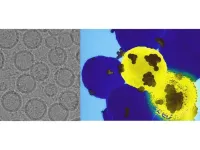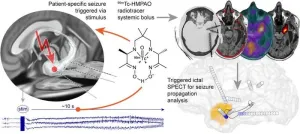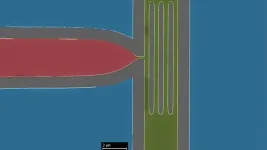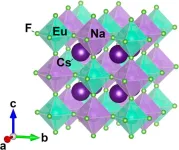(Press-News.org) While Instagram might have a reputation for superficiality — a realm of exquisitely filtered images — it is now eclipsing other social media as a news source. The platform is increasingly filled with information, some of it pernicious and distributed via influencers.
Researchers at the University of Washington studied three prominent Instagram influencers spreading anti-vaccine misinformation as a route to profit. Each account occupies what lead author Rachel E. Moran, a UW senior research scientist at the Center for an Informed Public (CIP) and staff researcher in the Information School, calls a “slightly different corner of Instagram.”
To protect the accounts’ anonymity, the team gave each a pseudonym, substituting the account’s actual name with a generic descriptor: the Wellness Homesteader (focused on things like homeschooling and farming), the Conspiratorial Fashionista (focused on fashion) and the Evangelical Mother (focused on Christianity). What unified the three U.S.-based accounts was that, amid their varied content, each dispersed overtly conspiratorial anti-vaccine messaging and used it to sell products and services they profited from either directly or indirectly.
The team recently published its findings in the International Journal of Communication.
UW News spoke with Moran about the paper, the particular methods of Instagram influencers, and the ways “misinformation is an immensely profitable endeavor.”
What made you interested in researching this?
Rachel Moran: A lot of my research at the CIP has been in the vein of health-related claims, particularly in the anti-vaccine movement. We've done a couple of research studies where we looked at how influencers on Instagram share information about vaccines, how they validate whether it's true or not. And we noticed this pattern of influencers directing people to buy things. It's something we see in our everyday lives all the time now. Everyone is selling something online. So we're interested in what happens when people use misinformation and leverage it to make profit.
Can you describe the patterns you found in the three accounts?
RM: They were all female and kind of catering to female audiences, and they leverage gender in a really interesting way. They're kind of homing in on mothers’ responsibilities so they can, for want of a better word, “guilt trip” people into buying specific products. They’re eschewing traditional vaccines or medicine in favor of more “natural wellness” products, for example.
We also saw the use of multilevel marketing companies. During the pandemic, the Food and Drug Administration tried to put a handle on some of these wellness-related multilevel marketing companies that were leveraging the pandemic as a way of advertising their products. The FDA came out and said, “You're not allowed to say that your product will cure COVID,” for example. There's a bit of a loophole, where you can sell a multilevel marketing product if you're not employed by that company. Then, the policies aren’t really enforceable. This allows individuals with these Instagram accounts to advertise the product and make money off of it by leveraging misinformation without any consequence.
In the paper, you discuss how the ‘parasocial relationships’ that develop through these kinds of accounts can help the anti-vaccine messaging gain users’ trust. Could you talk about that?
RM: It’s a through line to a lot of our work within misinformation spaces — the importance of these parasocial relationships, which are sort of one-sided relationships we build with the people that we follow online, celebrities and so on. But with Instagram, you get this look into someone's everyday life that sometimes can be very mundane, and you kind of build a rapport through that. They're showing content that feels relatable. Maybe you've bought the leggings that they've advertised, and they work well for you. You build up that incremental trust, so that if they then share something that isn't within their wheelhouse — maybe they're not medical experts, but they're sharing medical advice — you may be less likely to question it.
And it's not quite as one-sided anymore. On Instagram, we can reply to an influencer’s story, and they sometimes respond and provide a little semblance of a two-way relationship. This also means that they know that parasocial relationships are really important. It really shapes the content that we see and all kinds of influencers online. They know that their job is to build trust, and they can then use that trust to get people to buy things.
Could you give examples of ways you saw these influencers leveraging those sorts of relationships for profit?
RM: Often they would share throughout the day using Instagram Stories, which is this ephemeral content that disappears after 24 hours. Maybe it's just them getting up and getting their kids ready for school, or maybe their child is sick, and they say, “Okay, I'm not going to treat it with medicine, I'm going to treat it with this essential oil.” And then they would direct their followers to the link in their bio, or to swipe up on the story. And it would take the followers to a multilevel marketing campaign, or maybe an Amazon affiliate link, where they can purchase the product. Maybe it's very genuine, maybe they actually are using this product, and it's a safe product. But often, it would come with some sort of anti-vaccine rhetoric — this is what they’re choosing instead of a vaccine, which contains these free radicals or metals or whatever they’re claiming.
Instagram videos and images can convey a lot more information than more text-based social media. Just as much as that visual richness is a great tool for spreading good information, it's also a great tool for people who want to spread bad information. Because people often go to Instagram for entertainment, they’re not necessarily thinking as critically about the information that they’re seeing as they might be on a platform like X, where they anticipate encountering news. They aren’t thinking: “I have to question everything.” So they’re probably more vulnerable to misinformation.
A lot of attention has been paid to misinformation as a social and political tool. Why is it important for people to also pay attention to it as an economic phenomenon?
RM: I think it's important because it's an avenue that we've kind of forgotten about. In a way, I think we're all attuned to the fact that scams exist online and offline. But we think about the big stories: someone losing their life savings. Yet we're all kind of being scammed on a daily basis by being told that some products work when they don't or, on a more dangerous level, being told to choose certain products over those backed by proven scientific medical knowledge. Looking at those economic mechanisms helps us consider why we’re so attracted to misinformation.
In terms of intervention, we need to think about media literacy — how do we give people the skills to recognize when they're being scammed? And we need to think about what intervention looks like for these companies like Facebook and Instagram and Twitter. Or what it looks like for government. A lot of these tools are quite benign, like the fact that you can direct people off-platform to do certain things — that's all well and good, and it affords a richer conversation online. But these are the mechanisms that get taken advantage of. So what are ways that we can potentially curtail this problem?
Anything else you want to add?
RM: One thing that I think a lot about is that you now see things on Instagram that are fairly politically extreme, but feel quite normalized, because you're not always consuming the content in a really engaged way. So with these three influencers, the amount of content that is anti-vaccine is fairly small compared to the whole gamut of what they're sharing every day. But the nature of the content is extreme. It’s not hidden. It's not suggesting that you maybe should question getting a vaccine or talk to your doctor about getting a vaccine. It's often straight conspiracy theories about vaccines. It's quite jarring to see that a lot of this really hardcore anti-vaccine rhetoric comes from everyday people who get sucked in and make it their cause and share it alongside all of the other stuff that they do daily. We need to be attentive and discerning when we’re scrolling through TikTok or Instagram. We’re consuming so much on so many different topics so quickly, that if we step back and reflect on some of the things we’ve seen, they can often be quite extreme and extremely misinformed.
Co-authors include Anna L. Swan, who completed this research as a UW post-doctoral scholar with the CIP and is now at AnitaB.org, and Taylor Agajanian, who completed this research as a UW researcher with the CIP. This work was funded by the CIP and the John S. and James L. Knight Foundation.
For more information, contact Moran at remoran@uw.edu.
END
Q&A: How Instagram influencers profit from anti-vaccine misinformation
2024-03-12
ELSE PRESS RELEASES FROM THIS DATE:
Nancy Brown recognized as one of Modern Healthcare’s ‘Top Women Leaders’
2024-03-12
DALLAS, March 11, 2024 — Nancy Brown, Chief Executive Officer of the American Heart Association, a global force for healthier lives for all and celebrating one hundred years of lifesaving service, has been recognized by Modern Healthcare as one of the Top Women Leaders for 2024.
The publication’s recognition program acknowledges and honors women executives from all sectors of the healthcare industry for their contributions to care delivery improvement, health equity, policy and gender equity in healthcare leadership.
Since 2008, Brown has served as CEO of the Association, which is celebrating its 100th birthday in 2024. Awardees were selected based ...
India's water problems set to get worse as the world warms
2024-03-12
Winter storms that provide crucial snow and rainfall to northern India are arriving significantly later in the year compared to 70 years ago, a new study has found, exacerbating the risk of catastrophic flooding while also reducing vital water supplies for millions of Indians.
The cyclonic storms, known as western disturbances, typically bring heavy snow to the Himalayas from December to March. This snowpack slowly melts in spring, providing a steady supply of irrigation water for wheat and other crops downstream.
The study, published today (Tuesday, 12 March 2024), in the journal Weather and ...
GPS nanoparticle platform precisely delivers therapeutic payload to cancer cells
2024-03-11
UNIVERSITY PARK, Pa. — A newly developed “GPS nanoparticle” injected intravenously can home in on cancer cells to deliver a genetic punch to the protein implicated in tumor growth and spread, according to researchers from Penn State. They tested their approach in human cell lines and in mice to effectively knock down a cancer-causing gene, reporting that the technique may potentially offer a more precise and effective treatment for notoriously hard-to-treat basal-like breast cancers.
They published their work today (March 11) in ACS Nano. They also filed a provisional application to patent the technology ...
New method for triggering and imaging seizures can help guide epilepsy surgery
2024-03-11
Researchers have developed a new method for triggering and imaging seizures in epilepsy patients, offering physicians the ability to collect real-time data to tailor epilepsy surgery. In contrast to previous practice, where physicians from neurology and nuclear medicine had to wait for hours to days in hopes of capturing the onset of a seizure, the new method is convenient, spares resources, and is clinically feasible. This research was published in the March issue of The Journal of Nuclear Medicine.
People with epilepsy and seizures who do not respond to medication are often helped by brain surgery. The goal ...
Giving particle detectors a boost
2024-03-11
Device could help facilitate the operation of new particle colliders, such as the Electron-Ion Collider.
In particle colliders that reveal the hidden secrets of the tiniest constituents of our universe, minute particles leave behind extremely faint electrical traces when they are generated in enormous collisions. Some detectors in these facilities use superconductivity — a phenomenon in which electricity is carried with zero resistance at low temperatures — to function.
For scientists to more accurately observe the behavior of these particles, these weak electrical signals, or currents, need ...
Aging at AACR Annual Meeting 2024
2024-03-11
BUFFALO, NY- March 11, 2024 – Impact Journals publishes scholarly journals in the biomedical sciences with a focus on all areas of cancer and aging research. Aging is one of the most prominent journals published by Impact Journals.
Impact Journals will be participating as an exhibitor at the American Association for Cancer Research (AACR) Annual Meeting 2024 from April 5-10 at the San Diego Convention Center in San Diego, California. This year, the AACR meeting theme is “Inspiring Science • Fueling ...
Oncotarget at AACR Annual Meeting 2024
2024-03-11
BUFFALO, NY- March 11, 2024 – Impact Journals publishes scholarly journals in the biomedical sciences with a focus on all areas of cancer and aging research. Oncotarget is one of the most prominent journals published by Impact Journals.
Impact Journals will be participating as an exhibitor at the American Association for Cancer Research (AACR) Annual Meeting 2024 from April 5-10 at the San Diego Convention Center in San Diego, California. This year, the AACR meeting theme is “Inspiring Science • Fueling Progress • Revolutionizing Care.”
Visit booth #4159 at the AACR Annual Meeting 2024 to connect with members of ...
Analysis reveals long-term impact of calcium and vitamin D supplements on health in postmenopausal women
2024-03-11
Embargoed for release until 5:00 p.m. ET on Monday 11 March 2024
Annals of Internal Medicine Tip Sheet
@Annalsofim
Below please find summaries of new articles that will be published in the next issue of Annals of Internal Medicine. The summaries are not intended to substitute for the full articles as a source of information. This information is under strict embargo and by taking it into possession, media representatives are committing to the terms of the embargo not only on their own behalf, but also ...
Design rules and synthesis of quantum memory candidates
2024-03-11
In the quest to develop quantum computers and networks, there are many components that are fundamentally different than those used today. Like a modern computer, each of these components has different constraints. However, it is currently unclear what materials can be used to construct those components for the transmission and storage of quantum information.
In new research published in the Journal of the American Chemical Society, University of Illinois Urbana Champaign materials science & engineering professor Daniel Shoemaker and graduate student Zachary Riedel ...
BIDMC-led trial leads to FDA approval of coronary drug-coated balloons
2024-03-11
BOSTON – In the largest randomized clinical trial and first of its kind to date in the United States, a team led by investigators at Beth Israel Deaconess Medical Center (BIDMC) assessed the efficacy and safety of using a drug-coated balloon in patients undergoing coronary angioplasty. In an original investigation presented at the Cardiology Research Technology conference in Washington, D.C. and published simultaneously in JAMA, the team reports that patients treated with a balloon coated with paclitaxel, a drug to prevent restenosis, experienced lower rates of failure compared with patients treated with an uncoated balloon.
The findings of the trial—which ...





